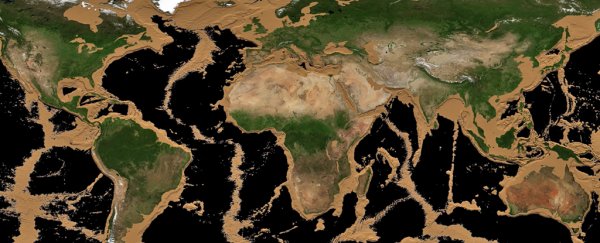Oceans cover most of the Earth, including its longest mountain range and the ancient bridges that humans crossed to reach other continents.
In a recent remake of a 2008 NASA video, planetary scientist James O'Donoghue shows what it would look like if all that water drained away, revealing the hidden three-fifths of Earth's surface.
O'Donoghue works at the Japan Aerospace Exploration Agency (JAXA) and was formerly at NASA. For the video, he took an animation that NASA physicist and animator Horace Mitchell created in 2008 and gave it a few additions. He edited the timing and added a tracker to show how much water drains throughout the animation.
Here's his slow-motion version:
As the oceans slowly lose water, the first bits of hidden land that emerge are the continental shelves – the undersea edges of each continent.
"I slowed down the start since, rather surprisingly, there's a lot of undersea landscape instantly revealed in the first tens of meters," O'Donoghue told Business Insider in an email.
The continental shelves include some of the land bridges that early humans crossed as they migrated from continent to continent. Tens of thousands of years ago, our ancestors could walk from continental Europe to the UK, from Siberia to Alaska, and from Australia to the islands surrounding it.
"When the last ice age occurred, a lot of ocean water was locked up as ice at the poles of the planet. That's why land bridges used to exist," O'Donoghue said. "Each of these links enabled humans to migrate, and when the ice age ended, the water sort of sealed them in."
By removing that water, the animation offers a glimpse at the world of our ancient ancestors.
It also shows Earth's longest chain of mountains, which appears once the sea levels have dropped 2,000 to 3,000 meters (6,500 to 9,800 feet). That's the mid-ocean ridge, which stretches over 37,000 miles (60,000 kilometers) across the globe. Over 90 percent of it is underwater.
The volcanic mountains spring up at the seams where Earth's tectonic plates inch away from each other, creating new ocean floor as molten rock rises from beneath the plant's crust.
Once the animated oceans drain by 6,000 meters (20,000 feet), most of the water is gone. But it takes nearly another 5,000 meters (16,000 feet) to empty the deepest reaches of the Marianas Trench.
"I like how this animation reveals that the ocean floor is just as variable and interesting in its geology as the continents," O'Donoghue said.
He added that emptying the seas unearths not only "not only the ocean bottom, but also the ancient story of humanity."
This article was originally published by Business Insider.
More from Business Insider:
